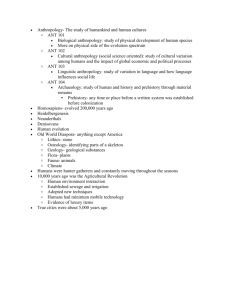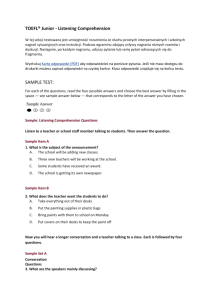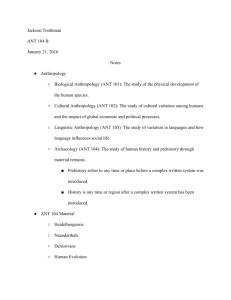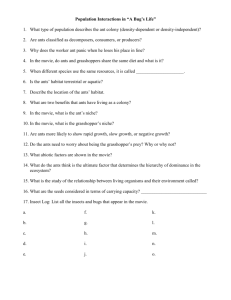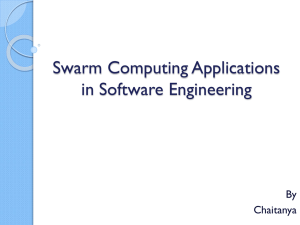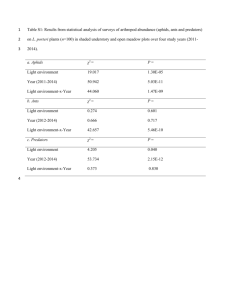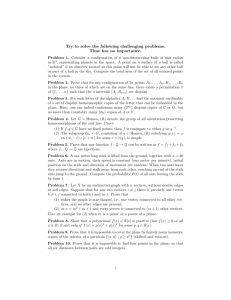A New Ant Algorithm for Graph Coloring
advertisement
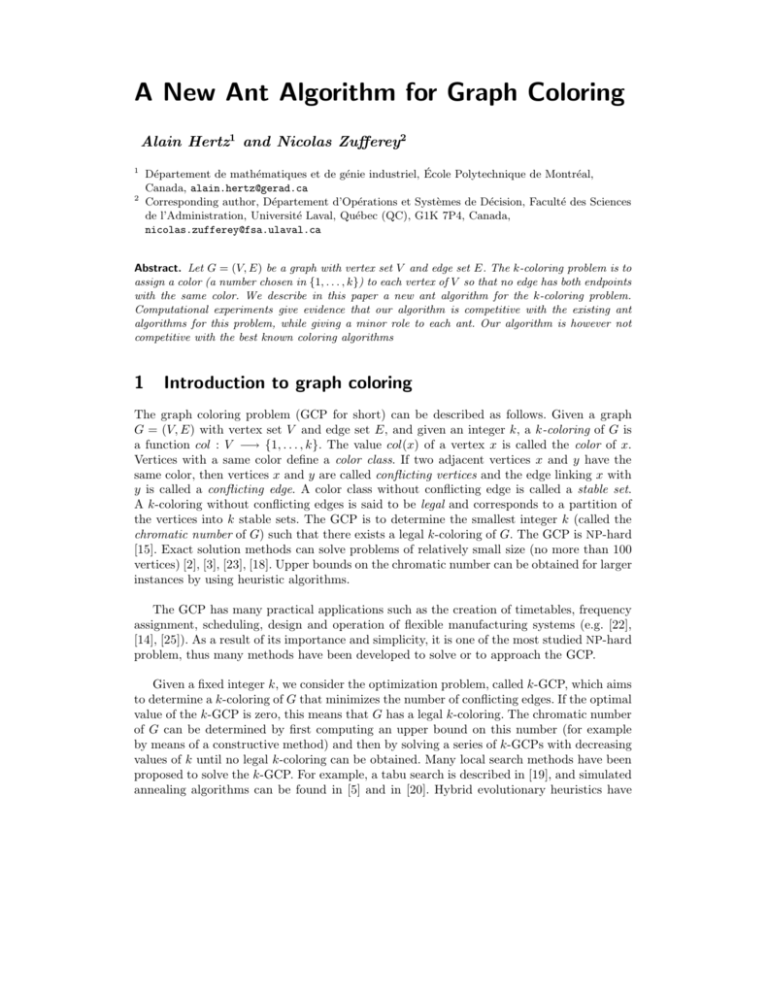
A New Ant Algorithm for Graph Coloring
Alain Hertz1 and Nicolas Zufferey2
1
2
Département de mathématiques et de génie industriel, École Polytechnique de Montréal,
Canada, alain.hertz@gerad.ca
Corresponding author, Département d’Opérations et Systèmes de Décision, Faculté des Sciences
de l’Administration, Université Laval, Québec (QC), G1K 7P4, Canada,
nicolas.zufferey@fsa.ulaval.ca
Abstract. Let G = (V, E) be a graph with vertex set V and edge set E. The k-coloring problem is to
assign a color (a number chosen in {1, . . . , k}) to each vertex of V so that no edge has both endpoints
with the same color. We describe in this paper a new ant algorithm for the k-coloring problem.
Computational experiments give evidence that our algorithm is competitive with the existing ant
algorithms for this problem, while giving a minor role to each ant. Our algorithm is however not
competitive with the best known coloring algorithms
1
Introduction to graph coloring
The graph coloring problem (GCP for short) can be described as follows. Given a graph
G = (V, E) with vertex set V and edge set E, and given an integer k, a k-coloring of G is
a function col : V −→ {1, . . . , k}. The value col(x) of a vertex x is called the color of x.
Vertices with a same color define a color class. If two adjacent vertices x and y have the
same color, then vertices x and y are called conflicting vertices and the edge linking x with
y is called a conflicting edge. A color class without conflicting edge is called a stable set.
A k-coloring without conflicting edges is said to be legal and corresponds to a partition of
the vertices into k stable sets. The GCP is to determine the smallest integer k (called the
chromatic number of G) such that there exists a legal k-coloring of G. The GCP is NP-hard
[15]. Exact solution methods can solve problems of relatively small size (no more than 100
vertices) [2], [3], [23], [18]. Upper bounds on the chromatic number can be obtained for larger
instances by using heuristic algorithms.
The GCP has many practical applications such as the creation of timetables, frequency
assignment, scheduling, design and operation of flexible manufacturing systems (e.g. [22],
[14], [25]). As a result of its importance and simplicity, it is one of the most studied NP-hard
problem, thus many methods have been developed to solve or to approach the GCP.
Given a fixed integer k, we consider the optimization problem, called k-GCP, which aims
to determine a k-coloring of G that minimizes the number of conflicting edges. If the optimal
value of the k-GCP is zero, this means that G has a legal k-coloring. The chromatic number
of G can be determined by first computing an upper bound on this number (for example
by means of a constructive method) and then by solving a series of k-GCPs with decreasing
values of k until no legal k-coloring can be obtained. Many local search methods have been
proposed to solve the k-GCP. For example, a tabu search is described in [19], and simulated
annealing algorithms can be found in [5] and in [20]. Hybrid evolutionary heuristics have
2
Alain Hertz and Nicolas Zufferey
also been successfully applied to this problem (e.g., [7], [13], [16]). For a recent survey, the
reader is referred to [17].
In this paper, we propose a new kind of ant algorithm for the GCP. Our main goal is to
show that even if we give a minor role to each ant, we can still obtain competitive results
in comparison with other ant heuristics for the GCP.
2
Ant algorithms and two existing adaptations to the GCP
Evolutionary heuristics encompass various algorithms such as genetic algorithms, scatter
search, ant systems and adaptive memory algorithms [4]. They can be defined as iterative procedures that use a central memory where information is collected during the search
process.
Ant colonies were introduced in [11] and in [8], and are derived from the observation
of ants in the nature: ants are able to find a shortest path between a food source and
the nest using a trail system (called pheromone). In these methods, the central memory is
modeled by a trail system. In the usual ant system, a population of ants is used, where each
ant is a constructive heuristic able to build a solution step by step. At each step, an ant
adds an element to the current partial solution. Each decision or move m is based on two
ingredients: the greedy force (short term profit for the considered ant) GF (m) and the trails
T r(m) (information obtained from other ants). Let M be the set of all the possible moves.
The probability pk (m) that ant k chooses move m is given by
pk (m) =
GF (m)α · T r(m)β
P
,
GF (m0 )α · T r(m0 )β
m0 ∈Mk (adm)
where α and β are parameters and Mk (adm) is the set of admissible moves that ant k can
perform. When each ant of the population has build a solution, the trails can be updated
for example as follows:
T r(m) = ρ · T r(m) + ∆T r(m), ∀m ∈ M,
where 0 < ρ < 1 is a parameter representing the evaporation of the trails, which is generally
close or equal to 0.9, and ∆T r(m) is a term which reinforces the trails left on move m by
the ant population. That quantity is usually proportional to the number of times the ants
performed move m, and to the qualityPof the obtained solutions when move m has been
performed. More precisely, ∆T r(m) = k ∆T rk (m), where ∆T rk (m) is proportional to the
quality of the obtained solutions when performing m. In some systems, the trails are updated
more often (e.g. each time a single ant has built its solution [10]). In hybrid ant systems,
the solutions provided by some ants may be improved using a local search technique. In the
max-min ant systems [26], the authors proposed to normalize GF (m) and T r(m) in order to
better control these ingredients and thus the search process. An overview of ant algorithms
can be found in [9].
Two ant heuristics for the GCP already exist in the literature. The first one was proposed
in [6]. In their method, each ant is a constructive heuristic derived from Dsatur [2] or from
NICSO 2006
3
RLF [22]. Let us denote these methods by ANT-DSATUR and ANT-RLF, respectively.
A move always consists in selecting a vertex and giving a color to it. The trail system is
modeled using a matrix T r(x, y) proportional to:
• the number of times vertices x and y have the same color in the solutions provided by
the ants;
• the quality of the solutions where col(x) = col(y).
Another ant coloring method was recently proposed in [24], where each ant is a local
search instead of a constructive heuristic. The authors consider (not necessarily legal) kcolorings and try to minimize the number of conflicts. The trail system is modeled, at
iteration t, by the use of an auxiliary graph G0 = (V, E 0 (t)) obtained from the original graph
G = (V, E) by adding edges. The edge set E 0 (t) such that E ⊆ E 0 (t) is updated at each
iteration t in the following way. If many ants give a different color to x and y such that edge
[x, y] ∈
/ E, then [x, y] is added to E 0 . A move consists in changing the color of a conflicting
vertex in G, while minimizing the number of conflicts associated with the auxiliary graph
G0 .
3
General approach and role of the ants
The new proposed ant coloring method differs from those in [6] and [24] in that the role of
each single ant is not to build a whole solution but only to contribute to give a color to a
single vertex. Also, on the contrary to the existing ant coloring algorithms, we only make one
solution evolve using a population of ants. We deal with (not necessarily legal) k-colorings
and try to minimize the number f of conflicts. We always associate:
• a color in {1, . . . , k} to each ant;
• k ants to each vertex.
Thus, we use |V | ants of each color. From a distribution of the ants on the vertices,
we deduce a coloring of the graph using a procedure, called Color, which is derived from
Dsatur [2] which we now describe.
Let A be a set of vertices which is initialized to V . At each step, Dsatur colors one vertex
in A as follows:
1. select the vertex x ∈ A with the largest saturation degree, which is the number of
different colors that are adjacent to x; if more than one vertex maximize the saturation
degree, the vertex with the largest number of adjacent vertices is chosen (ties are broken
randomly);
2. assign the smallest color to x without creating any conflict, and remove x from A.
Procedure Color differs from Dsatur as follows. Given a set A of vertices to be colored,
and given a k-coloring of the induced subgraph G0 = (V 0 = V − A, E 0 ) of G, the selection
of the next vertex x in A to be colored is done as in Dsatur, but we assign to x a color
that is represented by at least one ant on x, and among these colors, we choose the one that
minimizes the number of conflicts. If several colors are possible, we give to x the color which
is the most represented by the ants on x (ties are broken randomly).
4
Alain Hertz and Nicolas Zufferey
At the beginning of our method, we place one ant of each color on every vertex and we
set A = V . Thus, the first iteration of our method corresponds to an application of Dsatur.
Then, we iteratively modify the positions of the ants on the graph and, at the end of each
iteration, we recolor a subset A ⊆ V of vertices, using the Color procedure.
Note that one might propose, in the Color procedure, to always select the next vertex
to color as the vertex x in A such that x has the smallest number of colors represented
by the ants on it. Suppose for example that only ants of color 2 are on x. In this case, it
seems appropriate to color x as soon as possible because we can only give color 2 to it.
This strategy was tested but its performance was very poor. This is due to the fact that
such a strategy is not able to diversify the search process. Indeed, a vertex with very few
colors represented on it will always be colored first (or among the first ones), and the Color
procedure will probably always assign the same color to it.
Let ai and aj be two ants with colors i and j, respectively. Suppose that ai is on vertex
x and aj is on vertex y. A move m = (x, i) ↔ (y, j) consists in exchanging the positions
of ai and aj on vertices x and y. Thus, ai is moved from x to y and aj is moved from y
to x. At each iteration t of the algorithm, we modify the distribution of the ants on the
graph by performing a sequence of such moves, and we reassign a color to some vertices by
applying the Color procedure. We can already notice that each ant taken individually has
an influence only on the vertex on which it is laying. This is not a significant role at all! At
the end of each iteration t, it is important to reassign a color to:
1. all vertices x with a different set of ants on it (because it is forbidden to give a color to
x which is not represented by at least one ant on x);
2. all conflicting vertices (because the goal of one iteration is to try to remove some conflicts).
Thus, at iteration t, we use the following set A in the Color procedure (recall that A is
initialized to V ):
A = { vertices involved in a move at iteration t }
∪ { conflicting vertices at iteration t − 1 }.
An important issue is to define the set of moves to perform at iteration t (for any fixed
t). Let Nl (x, t − 1) be the number of ants of color l on x at iteration t − 1. The goal of
an iteration t is to change the color of at least one randomly chosen conflicting vertex x.
Suppose x has color i at iteration t − 1, thus Ni (x, t − 1) > 0 (otherwise the Color procedure
would not be able to assign color i to x at the end of iteration t − 1). In order to be sure
that we change the color of x using Color at the end of iteration t, we remove all ants of
color i from x, i.e. we perform a sequence of Ni (x, t − 1) moves m, chosen in the set
M (t) = {m = (x, i) ↔ (y, j) such that y 6= x, Nj (y, t − 1) > 0, j 6= i}.
Note that in order to reduce the risk of cycling, if we remove all the ants of color i from
vertex x, then we forbid to put an ant of color i on x during tab iterations, where tab =
UNIFORM(0, 9)+0.6·N CV (s), where s is the current solution and N CV (s) is the number of
conflicting vertices in s. The choice of such tab value is the one proposed in the efficient tabu
search coloring algorithm described in [16], which is derived from the tabu search proposed
NICSO 2006
5
in [19].
Another important issue is to define the way to select a move. As in most ant algorithms,
we choose at iteration t a move m according to the greedy force GF (m, t) and the trail
T r(m, t). Given α and β, we propose to always choose the move m that maximizes
p(m, t) = α · GF (m, t) + β · T r(m, t),
where GF (m, t) and T r(m, t) are normalized in [0; 1]. We use normalized quantities in order
to better control the weights of these ingredients during the process, as in some max-min
ant systems [26].
3.1
Definition of the greedy force
Recall that the greedy force represents the short-term profit of a single ant. At each iteration,
the short term profit consists in removing some conflicts. In order to remove a conflict, we
should remove some ant-conflicts, where an ant-conflict occurs when two ants of the same
color c are placed on two adjacent vertices x and y. Remember that in this case, the Color
procedure may give the same color c to x and y, because color c is represented on x and y.
Thus, a move with a large greedy force value should have the potential to significantly reduce
the number of ant-conflicts, and consequently the number of conflicts. Suppose we aim to
change the current color i of vertex x. We thus have to remove all the ants of color i from
vertex x. In order to do that, we perform a sequence of moves of type m = (x, i) ↔ (y, j).
For such a move m, we define the greedy force GF (m, t) by setting
GF (m, t) = Adv(m, t) − Disadv(m, t),
where Adv(m, t) and Disadv(m, t) are respectively the advantage and disadvantage of performing move m (i.e. exchanging ants ai and aj ) at iteration t. Note that we always normalize
Adv and Disadv in interval [0; 1].
Let S(x, y, i, t) be the number of ants of color i on vertices, different from y, which are
adjacent to x. An ant ai placed on vertex x is attracted by vertex y if:
1. there are several ants of color i on y;
2. there are several ants of color i on vertices, different from y, which are adjacent to x.
Similar considerations hold for the ant aj placed on vertex y which is candidate to be placed
on vertex x instead of ai . Thus, we can set
Adv(m, t) = Ni2 (y, t − 1) + S(x, y, i, t − 1)
+ Nj2 (x, t − 1) + S(y, x, j, t − 1).
Note that we respectively use Ni2 (y, t − 1) and Nj2 (x, t − 1) instead of Ni (y, t − 1) and
Nj (x, t − 1) in order to give more importance to the fact that ants with the same color
should be grouped together. In addition, preliminary experiments showed us that such a
formula leads to better results.
An ant aj placed on vertex y is not attracted by vertex x if:
6
Alain Hertz and Nicolas Zufferey
1. there are several ants of color j on y;
2. there are several ants of color j on vertices, different from y, which are adjacent to x.
As we know that all the ants of color i will be removed from x, vertex x is not attracted
by vertex y only if there are several ants of color i on vertices, different from x, which are
adjacent to y. Thus, we can set
Disadv(m, t) = Nj2 (y, t − 1) + S(x, y, j, t − 1) + S(y, x, i, t − 1).
3.2
Definition of the trail system
We first define the way to update the trail left by ants of color c on vertex v at the end of
iteration t:
tr(v, c, t) = ρ · tr(v, c, t − 1) + ∆tr(v, c, t),
where 0 < ρ < 1 is an evaporation parameter and the reinforcement value of color c on
vertex v is ∆tr(v, c, t). Note that evaporation and reinforcement may simultaneously occur,
as in any ant system.
We consider several cases. Suppose that during iteration t, the following events occurred:
1. x loses p = Ni (x, t − 1) ants of color i;
2. we put p ants on x, and the p ants have colors in the subset C(x) of {1, . . . , k};
3. the p new ants on x came from a subset of vertices P (x) of V .
A good trail system has to incorporate the following information:
1. if an ant of color c leaves vertex v, then tr(v, c, t) should be evaporated (this is especially
true for v = x and c = i) and not reinforced;
2. if no ant of color c leaves a vertex v ∈ P (x), then tr(v, c, t) should be evaporated and
slightly reinforced;
3. if an ant of color c arrives on vertex v, then tr(v, c, t) should be evaporated and reinforced,
and the reinforcement should be especially large if the generated solution s0 from s is
better than s, or better than s∗ , which is the best solution visited so far during the
search process;
4. if nothing occurs relatively to a vertex v and a color c, then tr(v, c, t) should be slightly
evaporated and not reinforced.
Preliminary experiments showed that the following parameter setting is appropriate.
•
•
•
•
•
•
•
ρ = 0.9 and ∆tr(v, c, t) = 2 · δ if v = x, c ∈ C(x);
ρ = 0.8 and ∆tr(v, c, t) = 0 if v = x, c = 1;
ρ = 0.9 and ∆tr(v, c, t) = 0 if v = x, c ∈
/ C(x) ∪ {i};
ρ = 0.9 and ∆tr(v, c, t) = 0 if v ∈ P (x), c such that there is an ant ac which left v;
ρ = 0.9 and ∆tr(v, c, t) = δ if v ∈ P (x) and c = i;
ρ = 0.9 and ∆tr(v, c, t) = δ2 if v ∈ P (x) and c such that there is no ant ac which left v;
ρ = 0.99 and ∆tr(v, c, t) = 0 if v ∈
/ {x} ∪ P (x) and c ∈ {1, . . . , k};
NICSO 2006
7
0.1 if f (s) − f (s0 ) ≥ 0
where δ = 0.2 if f (s) − f (s0 ) < 0
0.4 if f (s) − f (s∗ ) < 0
Remember that f (s) is the number of conflicts in solution s. We can now define the trail
of a move m at iteration t as follows:
T r[m = (x, i) ↔ (y, j), t] = tr(x, j, t) + tr(y, i, t) − tr(x, i, t) − tr(y, j, t).
Note that we initialize tr(x, j, 0) = 1, ∀x ∈ {1, . . . , n}, ∀j ∈ {1, . . . , k}, and we always
normalize the tr values in interval [0; 1].
4
General algorithm
We have now all the ingredients necessary to formulate a new ant heuristic for the k-GCP.
The main loop of our method, called AN T COL, stops when a maximum number M axIter
of iterations without improvement of the best solution s∗ encountered so far have been
performed. The algorithm is the following:
1.
2.
3.
4.
5.
6.
set t = 0;
place one ant of each color on each vertex;
initialize the trails of each color on each vertex to 1;
apply the Color procedure with A = V ; let s be the so obtained solution;
set t = 1, t0 = 1, A = V , f ∗ = f (s), and s∗ = s;
while t0 < M axIter and f ∗ > 0, do
(a) determine the set M (t) of the possible non tabu moves for iteration t;
(b) compute the greedy force GF (m, t) and the trail T r(m, t), ∀ ∈ M (t);
(c) normalize the greedy forces and the trails in [0, 1];
(d) perform the non tabu move m ∈ M (t) maximizing p(M, t); let m = (x, i) ↔ (y, j)
be such a move;
(e) while there is at least one ant of color i on x, perform the move m maximizing p(M, t)
among the moves in {m = (x, i) ↔ (y, j) ∈ M (t) | y 6= x and color j is represented on y};
(f) update the trails tr(v, c) for each vertex v and each color c, then normalize those
quantities;
(g) update the tabu status;
(h) set A = { vertices involved in a move performed at iteration t }∪{ conflicting vertices
at iteration t − 1 };
(i) update the colors of the vertices in A using the Color procedure; let s be the so
obtained solution;
(j) if f (s) < f ∗ , set s∗ = s, f ∗ = f (s), and t0 = −1;
(k) set t = t + 1 and t0 = t0 + 1;
Note that preliminary experiments showed that the use of M axIter = 5000 is appropriate: the method is usually not able to improve the solution s∗ further if we use a larger
value. Also, preliminary experiments showed that α = 1 and β = 5 are appropriate values
in the following formula: p(m, t) = α · GF (m, t) + β · T r(m, t). Thus, as we use normalized
values for the trails and the greedy forces, it is better to give more importance to the trails.
The reader interested in having more details on the parameter settings is referred to [27].
8
Alain Hertz and Nicolas Zufferey
5
Obtained results and conclusion
We will compare our ant coloring algorithm with some other coloring heuristics. We choose
to consider the following methods:
• Dsatur [2] which is a constructive algorithm,
• the ant algorithms ANT-DSATUR and ANT-RLF [6] (see Section 2);
• T abucol, which is a very well-known tabu search algorithm originally proposed in [19]
and improved in [16];
• GH, which is an hybrid genetic algorithm proposed in [16], and is now widely considered
as the best coloring heuristic; such a method uses T abucol as intensification procedure.
Note that the ant coloring heuristic proposed in [24] will not be considered because
of the following reasons. First, the authors mainly tested their method on very easy instances, namely le450 5a, le450 5b, le450 5c, le450 5d, le450 15a and le450 15b, which are
well-known benchmark instances [21]. But it is known that these instances can be optimally
colored by exact algorithms within a few seconds! Then, they tested their algorithm on non
standard random graphs they generated with a very small number of edges. However, no results is given for standard random graphs, and we have not been able to re-implement their
algorithm. Finally, notice that in their method, each ant is a whole local search coloring
heuristic, which means that, on the contrary to our method, an ant has a very significant
role. Consequently, it is not relevant to compare their hybrid algorithm with our method.
However, we compare our heuristic with another type of local search, namely T abucol, which
is considered as one of the most simple and efficient local search coloring algorithm [17].
The density of a graph is the average number of edges between two vertices. We compare
the above methods on several random graphs of size |V | ∈ {100, 300, 500, 1000} and density
d = 0.5. These graphs are obtained by linking a pair of vertices by an edge with probability
0.5, independently for each pair. It is known in the graph coloring community that random
graphs with d = 0.5 are hard to color. While the results obtained on these graphs are representative, the reader interested in having more details on the results obtained by AN T COL
and many other coloring heuristics on other instances is referred to [27].
All the experiments were done on a computer Silicon Graphics Indigo2 (195 MHz, IP28
processor). We will not present the detailed CPU times for each graph because of their large
variability. However, in order to give an idea of these CPU times, we mention that the time
needed by AN T COL to find a legal coloring varies from a few seconds to a few minutes if
|V | = 100, from a few minutes to an hour if |V | = 300, from one to three hours if |V | = 500,
and from three to eight hours if |V | = 1000. These computing times are comparable with
the ones needed by the other methods. Once again, the reader interested in getting more
detailed is referred to [27].
The results associated with ANT-DSATUR and ANT-RLF are taken from [6]. For the
other methods, we generated four graphs for each considered value of |V | and performed
four runs on each graph. The results are summarized in Table 1. For each size |V |, we give
the ”most likely” number of colors used by each method to generate legal colorings. By
”most likely”, we mean the number of colors for which the success rate was at least 50%. In
brackets, we mention the smallest number of colors found by each method on at least one
NICSO 2006
9
graph. For example, for |V | = 300, AN T COL will most likely build legal 39-colorings, and
will sometimes generate legal colorings using only 37 colors.
|V | ANT-RLF ANT-DSATUR DSATUR Tabucol GH ANTCOL
100 16 (15)
16 (15)
19 (18)
14
14 16 (16)
300 36 (35)
39 (38)
43 (42)
33
33 39 (37)
500 56 (55)
68 (67)
66 (65)
49
48 59 (57)
1000 111 (111)
121 (121)
115 (114)
89
84 106 (105)
Table 1: Comparison of AN T COL with five other heuristics
We can first observe that AN T COL is much better than Dsatur. However, both algorithms are based on the same coloring strategy, which is to iteratively select a vertex with
a large saturation degree, and to assign to it the best possible color. This means that the
ingredients we add to Dsatur in order to elaborate AN T COL are useful. The same conclusion holds when comparing Dsatur with ANT-DSATUR
Then, we can remark that as soon as |V | > 100, AN T COL is much better than ANTDSATUR, which is another ant algorithm also based on Dsatur. This probably indicates
that it is better to make one solution evolve instead of performing several multi-starts.
The same kind of remark holds if we compare AN T COL with ANT-RLF on graphs with
|V | = 1000.
Finally, we see that AN T COL is not competitive at all with T abucol, and thus with
GH which uses T abucol as intensification procedure. We think that this is mainly due to
the fact that in AN T COL, too many ingredients are used to define the greedy force and
the trail system. Thus, the algorithm is very slow because lots of computation is needed to
only change the color of a small number of vertices. This kind of conclusion also holds for
the two other existing ant heuristics for the GCP [6], [24].
Remember that in [6], an ant is a constructive heuristic, and in [24], an ant is a local
search heuristic. But in contrast, in AN T COL, each individual ant only helps giving a color
to a single vertex, which is not a significant role. Hence, we have shown that we can obtain
competitive results in comparison with other ant coloring methods by giving a minor role
to each ant.
References
1. Bloechliger, I., and Zufferey, N. 2004. A Reactive Tabu Search using Partial Solutions for the
Graph Coloring Problem, Technical Report, Institute of Mathematics, Swiss Federal Institute
of Technology, Lausanne
2. Brélaz, D. 1979. New Methods to Color Vertices of a Graph, Communications of ACM 22:
251–256
3. Brown, J.R. 1972. Chromatic Scheduling and the Chromatic Number Problem, Management
Science 19: 456–463
4. Calegari, P., Coray, C., Hertz, A., Kobler, D., and Kuonen, P. 1999. A Taxonomy of Evolutionary Algorithms in Combinatorial Optimization, Journal of Heuristics 5: 145–158
10
Alain Hertz and Nicolas Zufferey
5. Chams, M., Hertz, A., and de Werra, D. 1987. Some Experiments with Simulated Annealing
for Coloring Graphs, European Journal of Operational Research 32: 260–266
6. Costa, D., and Hertz, A. 1997. Ants can colour graphs, Journal of the Operational Research
Society 48: 295–305
7. Costa, D., Hertz, A., and Dubuis, O. 1995. Embedding of a Sequential Algorithm within an
Evolutionary Algorithm for Coloring Problems in Graphs, Journal of Heuristics 1 1: 105–128
8. Dorigo, M. 1992. Optimization, learning and natural algorithms (in Italian), Unpublished
doctoral dissertation, Politecnico di Milano, Dipartimento di Elettronica, Italy
9. Dorigo, M., Di Caro, G., and Gambardella, L.M. 1999. Ant algorithms for discrete optimization,
Artificial Life 5: 137–172
10. Dorigo, M., and Gambardella, L.M. 1997. Ant Colony System: a Cooperative Learning Approach
to the Traveling Salesman Problem, IEEE Transactions on Evolutionary Computation 1 1:
53–66
11. Dorigo, M. Maniezzo, V., and Colorni A. 1991. Positive feedback as a search strategy, Technical
Report 91-016, Politecnico di Milano, Dipartimento di Elettronica, Italy
12. Dorigo, M. Maniezzo, V., and Colorni A. 1996. The Ant System: Optimization by a Colony of
Cooperating Agents, IEEE Transactions on Systems, Man, and Cybernetics 26 1: 1–13
13. Fleurent, C., and Ferland, J. A. 1996. Genetic and Hybrid Algorithms for Graph Coloring,
Annals of Operations Research 63: 437–461
14. Gamst, A. and Rave, W. 1992. On the frequency assignment in mobile automatic telephone
systems, Proceedings of GLOBECOM’92
15. Garey, M., and Johnson, D. 1979. Computers and Intractability: a Guide to the Theory of
NP-Completeness, W.H. Freeman and Company, New York
16. Galinier, P., and Hao, J.K. 1999. Hybrid Evolutionary Algorithms for Graph Coloring, Journal
of Combinatorial Optimization 3: 379–397
17. Galinier, P., and Hertz, A. 2006. A Survey of Local Seach Methods for Graph Coloring, Computers & Operations Research, to appear.
18. Herrmann, F., and Hertz, A. 2002. Finding the chromatic number by means of critical graphs,
ACM Journal of Experimental Algorithmics 7/10: 1–9
19. Hertz, A., and de Werra, D. 1987. Using Tabu Search Techniques for Graph Coloring, Computing
39: 345–351
20. Johnson, D. S, Aragon, C. R., McGeoch, L. A., and Schevon, C. 1991. Optimization by Simulated Annealing: An Experimental Evaluation, Part II; Graph Coloring and Number Partitioning, Operations Research 39: 378–406
21. Johnson, D. S., and Trick, M. A. 1996. Proceedings of the 2nd DIMACS implementation challenge, DIMACS Series in Discrete Mathematics and Theoretical Computer Sciences, American
Mathematical Society 26
22. Leighton, F. T. 1979. A graph coloring algorithm for large scheduling problems, Journal of
Research of the National Bureau Standard 84: 489–505
23. Peemöller, J. 1983. A Correction to Brélaz’s Modification of Brown’s Coloring Algorithm, Communications of ACM 26: 593–597
24. Shawe-Taylor, J., Zerovnik, J. 2002. Ants and Graph Coloring, Proceedings of ICANNGA’01:
593–597
25. Stecke, K. 1985. Design planning, scheduling and control problems of flexible manufacturing,
Annals of Operations Research 3: 3–12
26. Stuetzle, T., and Hoos, H. 1997. Improving the Ant System: a Detailed Report on the MaxMin Ant System, Technical Report, Department of Computer Sciences - Intellectics Group,
Technical University of Darmstadt
27. Zufferey, N. 2002. Heuristiques pour les Problèmes de la Coloration des Sommets d’un Graphe
et d’Affectation de Fréquences avec Polarités, PhD. Thesis, École Polytechnique Fédérale de
Lausanne, Switzerland
